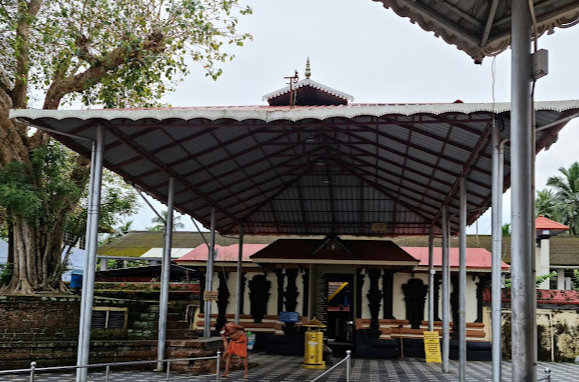The Thirunavaya Nava Mukunda Temple, originally constructed centuries ago, has witnessed significant historical events and endured various invasions and conflicts. These events led to the damage and destruction of the original structure. Over time, the temple was rebuilt in the traditional Kerala style of architecture, reflecting the resilience of the devotees and the enduring significance of the temple in the region. Despite these challenges, the temple has remained a revered site for worship, particularly as one of the 108 Divya Desams glorified by the Azhwar saints in their Tamil hymns.
Special Features:
One of the unique aspects of the Thirunavaya Nava Mukunda Temple is that the Thayaar, Periya Pirattiyar Lakshmi Devi, is enshrined in a separate sanctum (sannadhi). This is a rare feature among the Divyadesams of the Malayala Nadu region, making the temple particularly special and revered.
Temple Legend:
The presiding deity, Naavaay Mugundhan, is depicted in a standing posture (Nindra Thirukkolam) along the banks of the Bharathapuzha river. The temple's significance is further highlighted by the presence of Periya Pirattiyar Lakshmi Devi in her own separate shrine, a distinction among the Divyadesams in Malayala Nadu.
Opposite the Bharathapuzha river, there are separate temples dedicated to Lord Shiva and Brahma Devan. This unique combination allows devotees to worship all three members of the Trimurti—Brahma, Vishnu, and Shiva—in this sacred place, making it one of the few Divyadesams where such an arrangement exists.
The Legend of Lakshmi, Gajendran, and Navamukunda:
According to legend, Goddess Lakshmi and Gajendran (the elephant) both worshipped Lord Navamukunda with lotus flowers from a nearby pond. However, Lakshmi Devi became jealous of Gajendran, feeling that the flowers, and by extension the Lord, belonged solely to her. Aware of her thoughts, the Lord decided to teach her a lesson.
Lakshmi Devi, in her jealousy, began plucking all the flowers from the pond before Gajendran could offer them to the Lord. Gajendran, deeply saddened by this, cried out to Lord Navamukunda, praying for his intervention. Hearing Gajendran's plea, the Lord instructed Lakshmi Devi to cease her actions and instead, sit beside him to accept the flowers that Gajendran offered. Understanding her mistake, Lakshmi Devi complied, and from that moment on, she accepted the offerings from Gajendran alongside the Lord.
Through this divine play (Leelai), the Lord demonstrated that all beings (atma's) in the world deserve care and respect. If anyone interferes with another's devotion or disrespects their dedication, they should be taught a lesson to understand their error, just as the Lord did with Lakshmi Devi. The Lord honoured Gajendran's devotion while also helping Lakshmi Devi recognize the importance of accepting others' devotion.
In this temple, Naavaay Perumal is regarded as the father, Lakshmi Piratti as the mother, and Gajendran as their son, symbolising the familial bond and the lessons of respect and devotion.
Since Lakshmi Devi initially resisted Gajendran's offering of lotus flowers (Malar), she is named Malar Mangai Naachiyaar in this temple.
Pratyaksham for Nava Yogis:
Lord Naavaay Perumal also granted divine vision (Prathyaksham) to the Nava Yogis—Sathuvanathar, Saaloga Nathar, Aadhinathar, Arulithanathar, Madhanga Nathar, Macchendira Nathar, Kadayanthira Nathar, Korakka Nathar, and Kukkudanathar. These Yogis were great sages capable of performing significant Yagas (sacrificial rituals). Because of this connection, the temple was initially known as Thirunavayogi, which later evolved into Thirunaavaay.
The Temple's Equivalence to Kasi:
The presence of Lord Shiva alongside Perumal in this sthalam makes it as spiritually significant as the sacred city of Kasi (Varanasi). Devotees believe that worshipping here bestows the same blessings as those gained from visiting Kasi.
